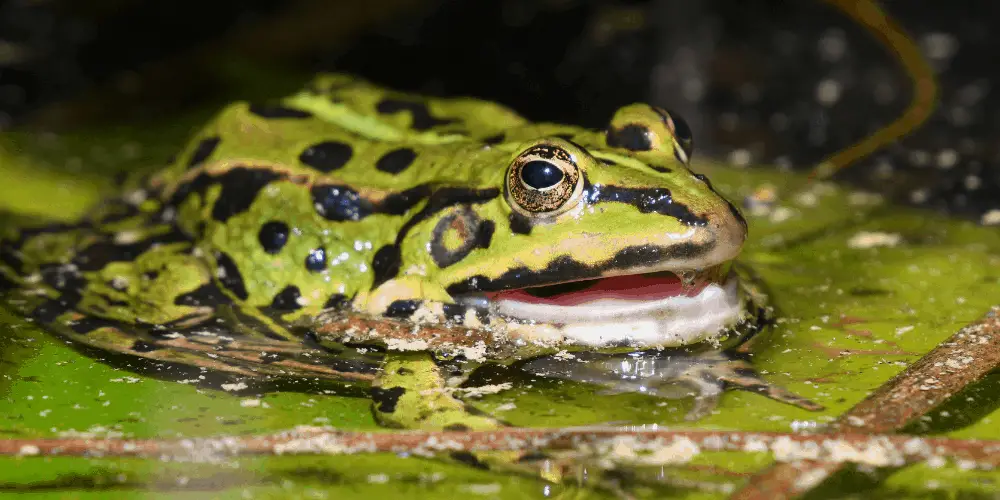There are several videos on sites like YouTube showing a group of frogs eating a variety of different insects. Although most people know this, many remain unsure about whether or not frogs eat bees.
Frogs eat bees and whatever is small enough to fit in their mouth and close enough to catch. They eat mostly small insects and invertebrates, but some species also eat plant matter. Although frogs eat different things, their diet is typically determined by the time of year.
Why are Bees in Frogs’ Diet?

Bees are a part of a frog’s diet because frogs will eat whatever is moving and close enough to catch. Frogs will not eat insects that aren’t moving since they rely on the insect’s movement to determine whether or not something is a food source.
While they can see unmoving objects to navigate their environment, they don’t realize something is food unless they see it moving. Because of this, frogs will eat bees that get too close to them since they are moving and small enough to fit in the frog’s mouth.
A frog’s visual system is specifically adapted to seeing little things that are moving across its field of vision – and not things that are sitting still. … It’s just that the part of the frog’s visual processing center that responds to stationary objects does not associate them with food.
How do Frogs Eat Bees?
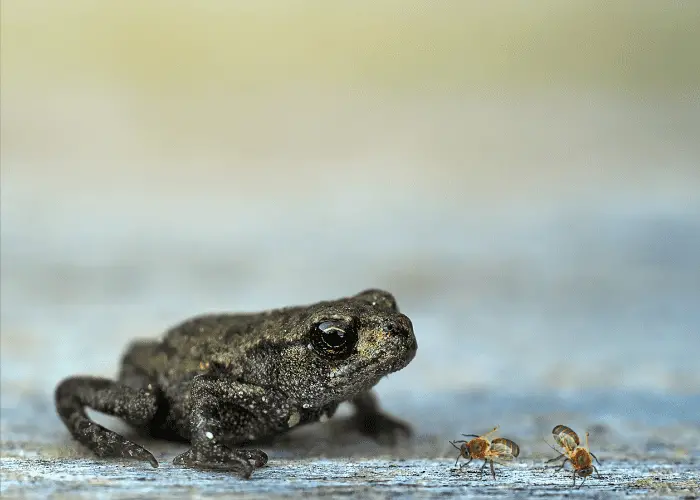
Frogs eat bees the same way they eat other insects. They have sticky tongues that allow them to catch any moving insect that comes into range quickly. Although their saliva is sticky when inside their mouths, frog saliva becomes watery when outside the mouth.
Once a frog catches an insect, like a bee, the saliva covers the insect. The frog brings its tongue back into its mouth and swallows the insect. Frogs can eat bees without getting stung largely because the bees are immobilized. However, they do, on occasion, get stung while trying to swallow bees.
What Happens When a Frog Eats a Bee?

Even if frogs can eat bees, it doesn’t mean they can do so without being stung. There’s a myth that frogs and toads are immune to bee stings. However, this myth is untrue since there is evidence that bees can sting frogs.
When a frog eats a bee, it typically swallows the insect before it can sting. In some cases, though, frogs can be stung before they have the chance to swallow the bee. When this happens, that frog will be hesitant to view these insects as a food source in the future.
Amphibians are very intelligent creatures that learn how to avoid bees and other insects with yellow and black stripes, especially if that frog has been stung in the past. Although bee stings still cause pain to frogs, the venom from the bee does not necessarily kill the frog.
Some species, like the African Bullfrog, can eat a variety of creatures with venomous stings. Despite being stung by bees, wasps, and scorpions, these frogs seem impervious to pain. However, reactions to stings vary greatly between different frog and toad species.
Do Frogs Get Stung When They Eat Bees?
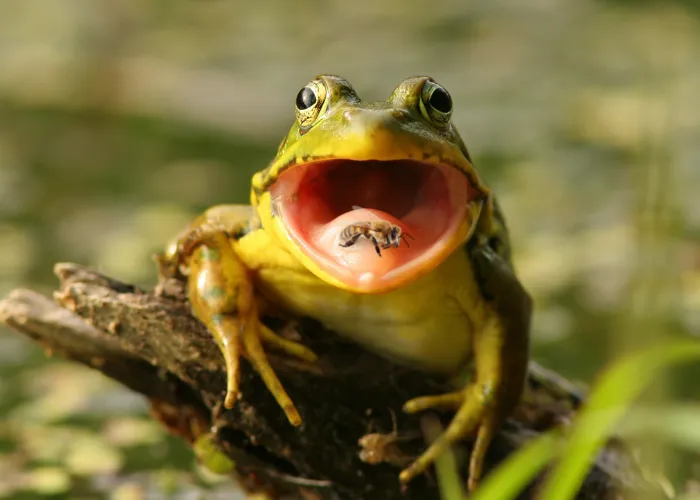
When frogs eat bees, they depend on their ability to immobilize the bee quickly before it’s able to sting. Although these efforts typically reduce the risk of stinging, frogs can still be stung when they eat bees.
Frogs can be stung while eating bees because bees can sting even after death. The muscles, nerves, exoskeleton, and venom sac can all work together to sting for several minutes after the frog catches a bee. This allows them to push venom into a frog’s body, even after death.
A bee’s stinger can still poke through a frog’s skin and cause pain long after a bee has died. However, frogs typically don’t register dead insects (including bees) as a food source, so they are unlikely to be stung by dead bees.
Are Bees Good for Frogs?
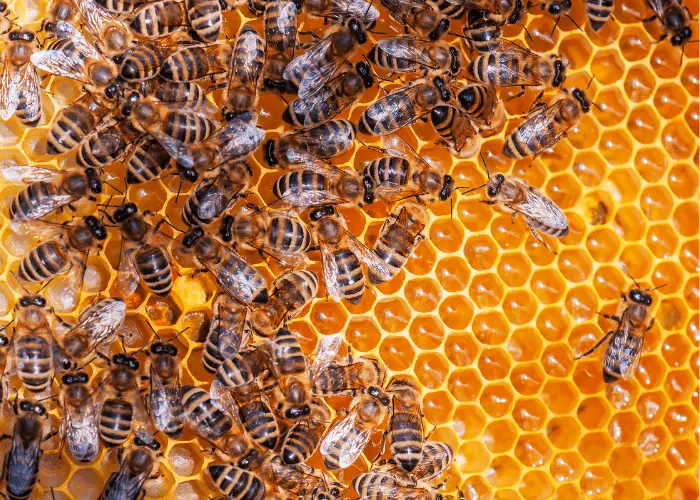
Since frogs will eat whatever is moving and close enough to catch, the nutritional value of their food is not something they consciously think about. However, bees offer vital nutrition to frogs. Bees are full of fat, protein, and micronutrients that allow frogs to survive.
The main drawback to eating bees is the occasional sting. Even though frogs use their tongues to immobilize their food, bees can occasionally sting frogs. These frogs experience pain and often make efforts to avoid bees in the future.
Final Thoughts:
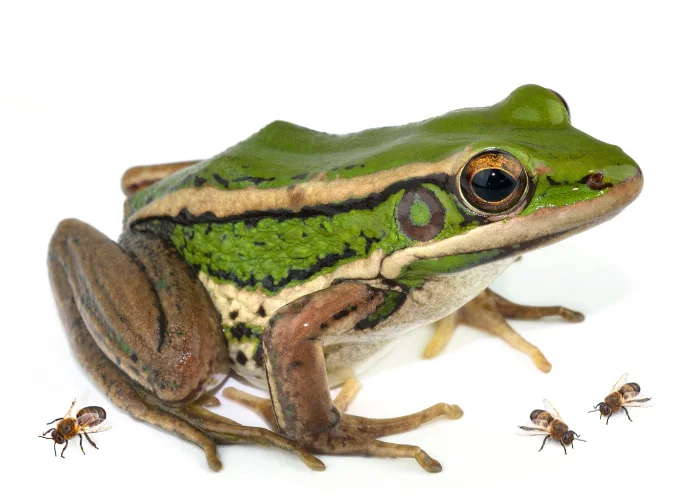
Frogs can eat bees, although many have learned to avoid unpleasant stings by foregoing opportunities to prey on bees.
When they eat bees, they typically immobilize the bee with their tongue before the bee has a chance to sting. Despite the myth that frogs cannot feel pain from bee stings, frogs can feel that pain when stung. Even after a bee has died, it can still inject its venom into a frog.
RELATED QUESTIONS:
1. What Do Frogs Eat?
Frogs are opportunistic feeders. They typically feed on almost anything– small insects like flies, moths, snails, slugs, and worms. When the opportunity presents itself, they may also eat other creatures such as small fish and frogs.
2. Do Frogs Eat Wasps?
While bees are capable of stinging only once before death, wasps are notorious for stinging several times. That makes them particularly dangerous to potential predators, including frogs. Despite the risks, will frogs eat wasps?
Frogs do not seek out wasps, but they won’t pass them up, either. If a wasp flies close enough, a frog will eat it. The wasp is typically swallowed before it has a chance to sting a frog, although stings do happen on occasion.
3. What Other Animals Eat Bees?
Bees, wasps, and other similar insects have black and yellow stripes that warn most predators.
Their stinging is an additional deterrent that prevents most predators from viewing them as a food source. However, some predators still choose to eat bees because they can avoid the stinging or withstand it.
Predators to bees include birds, mammals like bears and weasels, lizards, and other insects.
Birds that eat bees and wasps include birds in the “bee-eater” family found in tropical and subtropical regions. Mockingbirds, tanagers, blackbirds, magpies, and starlings also eat bees and wasps. When the insects fly close enough to nectar sources, ruby-throated hummingbirds may also eat bees or wasps.
Several mammals also view bees and wasps as food sources. Badgers, black bears, weasels, and mice have all been known to eat the insects. Black bears also enjoy the honey, making them a treat to individual bees and entire colonies.
Some lizards and other amphibians will feed on bees and wasps. Geckos often pursue wasps, even going into unguarded nests to eat wasp larvae. When those food sources are readily available, toads, frogs, and salamanders also eat bees, wasps, and their larvae.
Other insects such as dragonflies, robber flies, hornets, centipedes, and spiders eat bees and wasps. They use neurotoxins to paralyze prey, mitigating the risk of stinging. , If a bee or wasp gets close enough, praying mantises may also use them as a food source.


